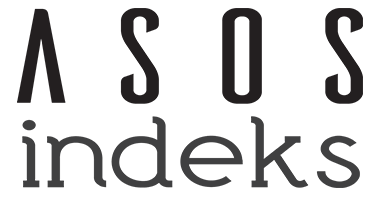The Effect of Preschool Learning Environments on Student-Teacher Relationship
Learning Environments, Preschool, Student Teacher Relationship
Keywords:
Preschool education, Learning Environments, Student Teacher RelationshipAbstract
The aim of the research is to determine the preschool learning environments and to examine the student-teacher relationship. The sample of the study, in which the relational survey model, one of the quantitative research methods, was used, consists of 6 independent kindergartens affiliated to the Directorate of National Education in Gaziantep province Şahinbey and Şehitkamil district center in the 2019-2020 academic year, 61 teachers working in these schools and 244 children aged 5 years in the class of these teachers. . In the study, the data were collected using the Learning Environments Evaluation Scale (ECERS R), developed by Harms and Clifford (1980) and adapted to Turkish by Kler Klodya Tovim (1996), and developed by Pianta (1999) and Ası and Karabay (2018) to determine the student-teacher relationship. The data were collected with the Student-Teacher Relationship Scale (SSPS-F), which was adapted into Turkish by The data obtained within the scope of the research were analyzed using SPSS (Version 24.0), regression and correlation analyzes were used as well as descriptive statistical methods. A positive relationship was found between the sub-dimensions of the ECERS-R scale, classroom space and furniture, routine personal care, activities and program structure, and the conflict sub-dimension, which is the sub-dimension of the Student-Teacher Relationship scale.
References
Aksoy, P. (2009). Okul öncesi eğitim kurumlarının eğitim ortamlarının niteliğinin bazı değişkenler açısından incelenmesi (Tokat İli Örneği). (Yayımlanmamış yüksek lisans tezi), Ankara Üniversitesi, Ankara.
Ası, D.Ş., ve Karabay, Ş.O. (2018). Öğrenci - Öğretmen İlişki Ölçeği-Kısa Formunun Türkçe’ye uyarlanması. Ege Journal of Education, 19(1), 67-82. Doi: 10.12984/egeefd.322358
Aydın Bilgin, N. H. (2003). Çocuk Ruh Sağlığı. İstanbul: Morpa Kültür Yayınları
Baker, J. A. (1999). Teacher-student interaction in urban at-risk classrooms: Differential behavior, relationship quality, and student satisfaction with school. The elementary school journal, 100(1), 57-70.
Birch, S. H., & Ladd, G. W. (1997). The teacher-child relationship and children's early school adjustment. Journal of school psychology, 35(1), 61-79.
Bourke, S. (1986). How smaller is better: Some relationships between class size, teaching practices, and student achievement. American Educational Research Journal, 23(4), 558-571.
Büyüköztürk, Ş., Çakmak, K. E., Akgün, E. Ö., Karadeniz, Ş. & Demirel, F. (2009). Bilimsel araştırma yöntemleri. Ankara: Pegem Akademi.
Büyüköztürk, Ş.(2012). Sosyal bilimler için veri analizi el kitabı. Pegem Akademi: Ankara
Cohen, L, Manion, L. &Morrison, K. (2010). A guide to teaching practice. (5th edition). London: Routledge.
Canbeldek, M. (2015). Okul öncesi eğitim kurumlarında kalite ile okul öncesi dönem çocuklarının gelişim düzeyleri arasındaki ilişkinin belirlenmesi. (Yayınlanmamış Yüksek Lisans Tezi), Pamukkale Üniversitesi Eğitim Bilimleri Enstitüsü, Denizli.
Demirkaya, P. N. (2013). Anasınıflarında özel gereksinimi olan ve olmayan öğrencilerin öğrenci öğretmen ilişkisinin incelenmesi. (Yayınlanmamış Yüksek Lisans Tezi). Ankara Üniversitesi, Ankara.
Dewey, J. F. (1969). Evolution of the Appalachian/Caledonian orogen. Nature, 222(5189), 124-129.
Driscoll, K. C., & Pianta, R. C. (2010). Banking time in head start: Early efficacy of an intervention designed to promote supportive teacher–child relationships. Early Education and Development, 21(1), 38-64.
Güleş, F. (2013). Okul öncesi eğitimde fiziksel çevreye ilişkin kalite standartlarının belirlenmesi. (Yayınlanmamış Doktora Tezi), Selçuk Üniversitesi: Konya.
Gürkan, T. (1985). Okul öncesi eğitim kurumlarında gözlenebilen uyum sorunları. İstanbul: Ya-Pa Yayınları.
Hamre, B. K., & Pianta, R. C. (2001). Early teacher–child relationships and the trajectory of children's school outcomes through eighth grade. Child development, 72(2), 625-638.
Howes, C. (2000). Social‐emotional classroom climate in child care, child‐teacher relationships and children’s second grade peer relations. Social development, 9(2), 191-204.
Kandır, A. ve Çaltık, İ. (2006). “Okul Öncesi Eğitim Kurumlarında Görevli Öğretmenlerin Okullarında Fiziksel Koşullarına ve Sınıflarındaki İlgi Köşelerinin Özelliklerine İlişkin Görüşlerinin İncelenmesi”, Mesleki Eğitim Dergisi, 8(15):40-62.
Mantzicopoulos, P. (2005). Conflictual relationships between kindergarten children and their teachers: Associations with child and classroom context variables. Journal of School Psychology, 43(5), 425-442.
Mashburn, A. J., Pianta, R. C., Hamre, B. K., Downer, J. T., Barbarin, O. A., Bryant, D., ... & Howes, C. (2008). Measures of classroom quality in prekindergarten and children’s development of academic, language, and social skills. Child development, 79(3), 732-749.
McGiverin, J., Gilman, D., & Tillitski, C. (1989). A meta-analysis of the relation between class size and achievement. The Elementary School Journal, 90(1), 47-56.
MEB, (2013). Temel eğitim Genel Müdürlüğü Okul Öncesi Eğitim Programı. Ankara: Milli Eğitim Basımevi. Erişim Tarihi: 18.03.2020. https://tegm.meb.gov.tr/dosya/okuloncesi/ooproram.pdf
METİN, Ş. (2016). Türkiye’de okul öncesinde kaynaştırmaya ilişkin yapılan çalışmaların incelenmesi. Bayburt Eğitim Fakültesi Dergisi, 8(1), 146-172.
National Association for the Education of Young Children. (2009). Developmentally appropriate practice in early childhood programs serving children from birth through age 8. Position Statement.
Nummila, M. (2016). Varhaiskasvatuksen oppimisympäristöjen ja varhaiskasvatussuunnitelmien ECERS-R laatu.
O'Connor, E. (2010). Teacher–child relationships as dynamic systems. Journal of school psychology, 48(3), 187-218.
O'Connor, E., & McCartney, K. (2006). Testing associations between young children's relationships with mothers and teachers. Journal of educational psychology, 98(1), 87.
Oğuzkan, Ş. ve Oral, G. (1997). Okulöncesi Eğitimi. İstanbul: Milli Eğitim Basımevi
Ömeroğlu, E. (2011). Okul öncesi eğitim kurumlarının fiziksel ve eğitsel ortamları. Ş. Yaşar. (Ed.), Okul Öncesi Eğitime Giriş (ss.83-100). Eskişehir: Anadolu Üniversitesi.
Pianta, R. C., Steinberg, M. S., & Rollins, K. B. (1995). The first two years of school: Teacher-child relationships and deflections in children's classroom adjustment. Development and psychopathology, 7(2), 295-312.
Pianta, R. C., & Walsh, D. J. (1998). Applying the construct of resilience in schools: Cautions from a developmental systems perspective. School Psychology Review, 27(3), 407-417.
Pianta, R. C. (1999). Enhancing relationships between children and teachers. American Psychological Association.
Pianta, R. C., Hamre, B., & Stuhlman, M. (2003). Relationships between teachers and children.
Pianta, R., Howes, C., Burchinal, M., Bryant, D., Clifford, R., Early, D., & Barbarin, O. (2005). Features of pre-kindergarten programs, classrooms, and teachers: Do they predict observed classroom quality and child-teacher interactions?. Applied developmental science, 9(3), 144-159.
Polat, A. E. (2014). Okulöncesi eğitim kurumlarındaki kalitenin çocuğun yaratıcılığına etkisi. (Yayımlanmamış Yüksek Lisans Tezi). İstanbul Sabahattin Zaim Üniversitesi, İstanbul.
Sabol, T. J., & Pianta, R. C. (2012). Recenttrends in research on teacher–childrelationships. Attachment& Human Development, 14(3), 213–231. Retrievedfrom https://0- doi.org.pacificatclassic.pacific.edu/10.1080/14616734.2012.672262
Serdaroğlu, H. U. (2019). Okul Öncesi Eğitim Ortamlarının Kalitesi ile Çocukların Dil Gelişim Düzeylerinin İncelenmesi. (Yayınlanmamış Yüksek Lisans Tezi)Gazi Üniversitesi: Ankara.
Solak, N. (2007). Adana İl Merkezinde Bulunan Okulöncesi Eğitim Kurumlarında Kalitenin İncelenmesi. Yayınlanmamış yüksek lisans tezi, Çukurova Üniversitesi, Adana.
Tekmen, B. (2005). A study on the structural and process of early childhood and care centers in Ankara. Unpublished master thesis, METU, Ankara.
Thurlow, M. L., Ysseldyke, J. E., Wotruba, J. W., & Algozzine, B. (1993). Instruction in special education classrooms under varying student-teacher ratios. The Elementary School Journal, 93(3), 305-320.
Tovim, K. K. (1996). The Turkish Adaptation of the Early Childhood Rating Scale. Unpublished master thesis). Boğaziçi University.
Ulcay, S. (1993), Okul öncesi çocuk gelişimi ve eğitim kurumlarında yıllık program. İstanbul: MEB Basımevi.
Downloads
Published
How to Cite
Issue
Section
License
Copyright (c) 2022 International Journal of Trends and Developments in Education

This work is licensed under a Creative Commons Attribution-NonCommercial-NoDerivatives 4.0 International License.
For more information click here.






